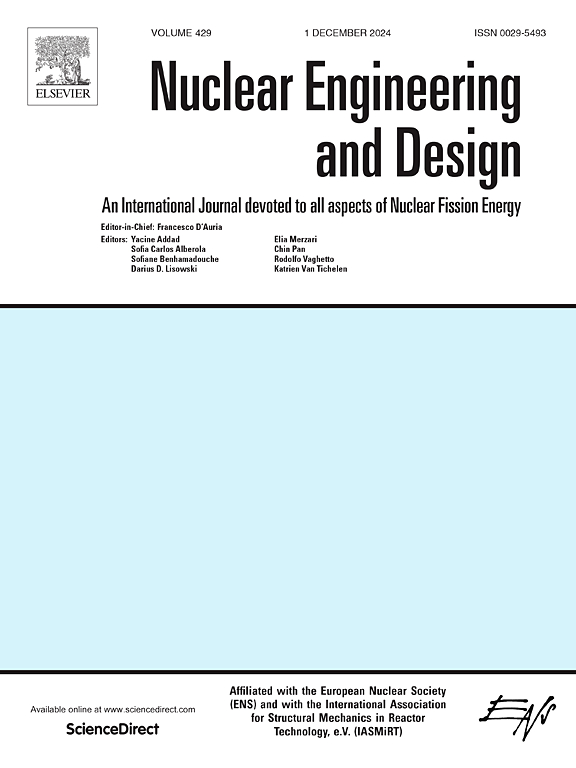Development of computationally effective models for simulation of steam injection effects on the pool stratification and mixing
IF 2.1
3区 工程技术
Q1 NUCLEAR SCIENCE & TECHNOLOGY
引用次数: 0
Abstract
Steam injection through blowdown pipes and spargers into a large water pool, also known as Pressure Suppression Pool (PSP), is employed in Boiling Water Reactors (BWRs) to prevent containment overpressure. Thermal stratification in the pool results in an increased pool surface temperature compared to a mixed pool condition, leading to higher containment pressure. Therefore, adequately validated predictive capabilities for modeling of the pool behavior are essential for the safety analysis of containment performance. The thermal behavior of the pool (e.g. thermal stratification or mixing transient) depends on the interplay between the heat and momentum sources induced by direct contact condensation of steam. Computational efficiency of the models for the simulation of the long transients in the large-scale pools is critical, especially for the quantification of uncertainties. The Effective Heat Source (EHS) and Effective Momentum Source (EMS) models have been developed to represent the impact of steam injection on the pool while avoiding the detailed simulation of steam-water interface dynamics, which is a computational challenge in itself. These models are compatible with any Computational Fluid Dynamics (CFD) code using a single-phase solver. In this work we further develop the EHS/EMS models using (i) new EMS model correlation based on the latest results from Separate Effect Test (SEF-POOL) facility; and (ii) Condensation-Induced Turbulence (CIT) model calibrated against integral pool experiments conducted at PANDA, PPOOLEX, SJTU, and HEU facilities under a wide range of steam injection conditions. The good agreement of the global pool behavior and local flow characteristics demonstrates that the proposed models can provide an adequate prediction of the relevant phenomena.
建立了有效的蒸汽注入对池分层和混合影响的计算模型
在沸水反应堆(BWRs)中,蒸汽通过排污管和喷雾器注入一个大的水池,也称为压力抑制池(PSP),以防止安全壳超压。与混合池条件相比,池中的热分层导致池表面温度升高,从而导致更高的安全壳压力。因此,充分验证池行为建模的预测能力对于安全壳性能的安全分析至关重要。池的热行为(如热分层或瞬态混合)取决于蒸汽直接接触冷凝引起的热源和动量源之间的相互作用。模型的计算效率对于模拟大规模池中的长瞬态是至关重要的,特别是对于不确定性的量化。有效热源(EHS)和有效动量源(EMS)模型是为了反映蒸汽注入对池的影响而建立的,同时避免了对蒸汽-水界面动力学的详细模拟,这本身就是一个计算挑战。这些模型与使用单相求解器的任何计算流体动力学(CFD)代码兼容。在这项工作中,我们进一步发展了EHS/EMS模型,使用:(i)基于独立效应测试(self - pool)设施的最新结果的新的EMS模型相关性;(ii)根据在PANDA、PPOOLEX、上海交通大学和高浓铀设施在大范围注汽条件下进行的积分池实验校准的冷凝诱导湍流(CIT)模型。整体池态和局部流动特征的良好一致性表明,所提出的模型可以对相关现象提供充分的预测。
本文章由计算机程序翻译,如有差异,请以英文原文为准。
求助全文
约1分钟内获得全文
求助全文
来源期刊

Nuclear Engineering and Design
工程技术-核科学技术
CiteScore
3.40
自引率
11.80%
发文量
377
审稿时长
5 months
期刊介绍:
Nuclear Engineering and Design covers the wide range of disciplines involved in the engineering, design, safety and construction of nuclear fission reactors. The Editors welcome papers both on applied and innovative aspects and developments in nuclear science and technology.
Fundamentals of Reactor Design include:
• Thermal-Hydraulics and Core Physics
• Safety Analysis, Risk Assessment (PSA)
• Structural and Mechanical Engineering
• Materials Science
• Fuel Behavior and Design
• Structural Plant Design
• Engineering of Reactor Components
• Experiments
Aspects beyond fundamentals of Reactor Design covered:
• Accident Mitigation Measures
• Reactor Control Systems
• Licensing Issues
• Safeguard Engineering
• Economy of Plants
• Reprocessing / Waste Disposal
• Applications of Nuclear Energy
• Maintenance
• Decommissioning
Papers on new reactor ideas and developments (Generation IV reactors) such as inherently safe modular HTRs, High Performance LWRs/HWRs and LMFBs/GFR will be considered; Actinide Burners, Accelerator Driven Systems, Energy Amplifiers and other special designs of power and research reactors and their applications are also encouraged.
 求助内容:
求助内容: 应助结果提醒方式:
应助结果提醒方式:


